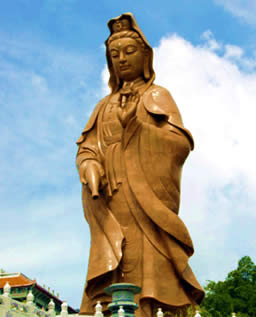
…or Kuanshih Yin, Kwan Yin, Guanyin, Quan’Am, Kannon, Kanin, Kwannon, just to name a few of the different spellings for Quan Yin.
In China, Quan Yin is known as the Goddess of Mercy, the embodiment of compassionate, loving kindness, “She who harkens to the cries of the world.” She carries the same connotations as our Mother Mary, Isis, Shakti, Paravati, Radha or Sita. She is perhaps one of the most common “eastern icons” to be found on the market (besides Buddha, of course).
Legend says that Quan Yin is a bodhisattva, or “ enlightened one”, but she took a vow to not enter heaven until everyone of us becomes enlightened. Basically, helping all other souls through their journey in this life and onto the next. Quan Yin is often depicted with one or more dragons, which are an ancient symbol for wisdom, high spirituality, strength & divine power of transformation. Often she is depicted carrying the pearls of illumination, a sheaf of ripe rice, a bowl of rice seed (used as a metaphor for sustenance and fertility), or a kalasa. ‘Kalasa’ in Buddhism is a vase. The kalasa is filled with the “water of life”, with this water all living things are blessed with spiritual peace. Other symbols associated with Quan Yin are a willow branch (used to sprinkle the divine nectar of life), a dove (representing fecundity), a book of scrolls or prayers (to represent the teaching of the buddha), and a rosary.
In Mahayana Buddhism and Hinduism, we find Avalokitesvara, the male embodiment of compassion. Who was born from a ray of light that sprang from Amitabha Buddha’s right eye, while he was in a state of ecstasy. Often pictures or statues of Avalokitesvara depict him with multiple arm’s and heads, the story is told that Avalokiteswara “the compassionate one”, descended into hell converted the wicked, liberated them and conducted them to the paradise of his spiritual father, Amitabha. Avalokiteswara discovered that for every culprit converted and liberated another instantly took his place and legend claims that his head split into ten pieces from grief and despair on discovering the extent of wickedness in the world and the utter hopelessness of saving all mankind. Amitabha caused each piece to become a head and placed the head on the body of his spiritual son. Avalokiteswara, in three tiers, heads of three, with the tenth head on top and his own image above them all. Thus, the “one looking Lord “ was endowed with twenty two eyes instead of two, to see all suffering, and eleven brains instead of one, to concentrate on the best means of saving mankind. The three tiers of heads indicate that Avalokiteswara looks down on the three world, word of desire, world of live form and world of no form. Avalokiteswara’s mantra is “ om mani padme hung”, (the jewel in the lotus). Some believe that our Dali Lama is an incarnation of Avalokiteswara.
In Tibet, we find Chengresik, is the name of their compassionate God.
Which ever name you use to call upon her is up to you, your prayers will always be heard and answered. Quan Yin is not bound to any one religion, only distressed hearts and souls.
Quan Yin works with the sixth ray, the indigo ray and the third eye. According to Doreen Virtue in Archangels and Ascended Masters ,her color is red, the color of passion and compassion. Quan Yin can aid with compassion, clairvoyance, feminine grace, beauty & power, kindness, love (receiving and giving), mercy, music abilities, protection, fertility & children, spiritual gifts & enlightenment. Her mantra is “namah quan shah yin pu’ sah”, pronounced “na moh quan shi yin pooh sah”
There is no sacred ritual that must be conducted for invoking Kuanshih Yin, just call out her name with great sincerity and your prayers will be heard. You can also recite her mantra whenever you feel you need to.

